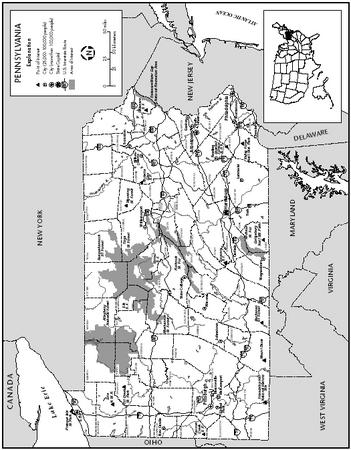Pennsylvania
Environmental protection
Pennsylvania's environment was ravaged by uncontrolled timber cutting in the 19th century, and by extensive coal mining and industrial development until recent times. Pittsburgh's most famous landmarks were its smokestacks, and it was said that silverware on ships entering the port of Philadelphia would tarnish immediately from the fumes of the Delaware River. The anthracite-mining regions were filled with huge, hideous culm piles, and the bituminous and anthracite fields were torn up by strip-mining. In 1979, a different kind of threat to Pennsylvania's environment received worldwide attention when the nuclear power plant at Three Mile Island seriously malfunctioned.
In 1895, Pennsylvania appointed its first commissioner of forestry, in an attempt to repair some of the earlier damage. Gifford Pinchot, who twice served as governor of Pennsylvania, was the first professionally trained forester in the US (he studied at the Ècole National Forestiere in Paris), developed the US Forest Service, and served as Pennsylvania forest commissioner from 1920 to 1922. In 1955, the state forests were put under scientific management.
In 1972, Pennsylvania voters ratified a state constitutional amendment adopted 18 May 1971, acknowledging the people's "right to clean air, pure water, and to the preservation of the natural, scenic, historic, and esthetic values of the environment" and naming the state as trustee of these resources. Passage of the amendment came only two years after establishment of the Pennsylvania Department of Environmental Resources, which in the 1990s was reorganized into two separate entities. The Department of Conservation and Natural Resources (DCNR) was established on 1 July 1995 to maintain and preserve the state's 116 state parks, manage the 2.1 million acres of state forest land, and provide information on the state's ecological and geologic resources. The DCNR also oversees environmental education and provides assistance and grants for preserving rivers, community trails, parks, and recreation. The Pennsylvania Department of Environmental Protection (DEP) was established to protect the state's air, land, and water from pollution and to provide a cleaner environment for the health and safety of Pennsylvania's citizens. After miners were trapped (and subsequently successfully rescued) in an accident at Quecreek Mine in July 2002, the DEP launched a program to build a database of abandoned mine locations to minimize the risk of another such accident occurring.
As of the early 1990s, sewage and industrial wastes were the major pollutants in areas with high industrial and population concentrations. In western and parts of central Pennsylvania, drainage from abandoned bituminous coal mines created serious water quality problems; active mines in this region were also potentially polluting. A similar situation prevailed in the anthracite areas of northeastern Pennsylvania. Oil and gas well operations, located primarily in the northwestern portion of the commonwealth, were additional pollution sources. In 2003, Pennsylvania had 572 hazardous waste sites listed in the Environmental Protection Agency's database, 94 of which were

In March 1979, Pennsylvania suffered the worst nuclear-power accident in US history when a nuclear reactor on Three Mile Island malfunctioned and radioactive gases escaped. A second reactor was shut down immediately even though it was not damaged. The cleanup of radioactive waste cost about $1 billion, and it was not until late 1985 that the undamaged unit was placed back in operation.
An oil spill at Marcus Hook, near the Delaware Border, released 435,000 gallons of crude oil into the Delaware River in September 1985; damage to birds and wetlands was more extensive in Delaware than in Pennsylvania.
In 2001, Pennsylvania received $197,186,000 in federal grants from the Environmental Protection Agency; EPA expenditures for procurement contracts in Pennsylvania that year amounted to $63,078,000.